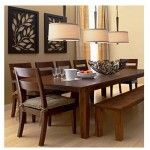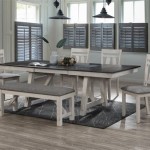Black and White Dining Room Pictures: A Study in Timeless Elegance
The allure of black and white in interior design lies in its inherent versatility and enduring appeal. When applied to the dining room, this classic combination creates a sophisticated and visually striking space. Black and white dining room pictures showcase a diverse range of styles, from ultra-modern to comfortably traditional, all united by the power of contrast and the freedom it offers for incorporating textures, patterns, and accent colors.
The absence of vibrant color allows for a heightened appreciation of form and detail. Architectural elements, furniture silhouettes, and decorative accessories all take on a different dimension when presented against the backdrop of a monochrome palette. The interplay of light and shadow becomes more pronounced, adding depth and drama to the dining room aesthetic. Furthermore, a black and white base provides a neutral canvas upon which to layer personality and flair, making it an ideal choice for individuals with evolving tastes or those who enjoy frequent redecorating.
Understanding the nuances of effectively incorporating black and white into a dining room involves considering factors such as the room's size, natural light, and the desired overall ambiance. A small dining room, for instance, may benefit from predominantly white walls to maximize the feeling of spaciousness, while larger rooms can handle a greater proportion of black without feeling cramped. Similarly, a dining room with abundant natural light can support a bolder use of black, while a room with limited sunlight may require a more strategic approach to ensure it remains bright and inviting.
Key Point 1: Mastering the Balance: The Foundation of a Successful Black and White Dining Room
Achieving visual harmony in a black and white dining room hinges on a well-considered balance between the two tones. An overly dominant use of either black or white can lead to an unbalanced and unappealing space. Strategies for achieving this balance include the 60-30-10 rule, a common design guideline that suggests dedicating approximately 60% of the room to white, 30% to black, and 10% to an accent color or metallic finish.
However, the 60-30-10 rule should be considered a flexible framework rather than a rigid formula. The specific proportions of black and white will depend on individual preferences and the characteristics of the dining room itself. For example, a dining room with high ceilings might benefit from a higher proportion of black on the lower walls to ground the space and create a sense of intimacy. Conversely, a dining room with low ceilings might benefit from a primarily white color scheme to visually lift the ceiling and make the room feel taller.
The placement of black and white elements is equally important. Consider using black strategically to highlight architectural features such as wainscoting, crown molding, or a fireplace surround. Black furniture, such as a dining table or chairs, can also serve as focal points, anchoring the space and adding visual weight. White, on the other hand, is ideal for walls, ceilings, and larger surfaces to reflect light and create a sense of openness. The integration of patterns, such as geometric designs or floral motifs, can further contribute to a balanced and visually interesting composition.
Another aspect of mastering the balance is paying attention to the nuances of each color. White, for instance, encompasses a wide spectrum of shades, from stark, clinical whites to warmer, creamier tones. Similarly, black can range from deep, saturated blacks to softer, charcoal grays. Choosing the right shades of black and white is crucial for creating the desired mood and aesthetic. Warmer whites tend to create a more inviting and comfortable atmosphere, while cooler whites evoke a more modern and minimalist feel. Charcoal grays can be a good option for those who want to introduce black without overwhelming the space.
Key Point 2: Textural Depth: Adding Interest and Dimension to a Monochrome Scheme
Without the distraction of color, texture becomes paramount in a black and white dining room. The strategic use of different textures is essential for preventing the space from feeling flat and one-dimensional. Texture adds visual interest, tactile appeal, and depth, transforming a simple monochrome scheme into a sophisticated and engaging environment.
Consider incorporating a variety of textures through different materials and finishes. For example, a smooth, glossy black dining table can be contrasted with upholstered white chairs in a textured fabric such as linen or velvet. A woven rug in a black and white pattern can add warmth and visual interest to the floor. A textured wallpaper, such as grasscloth or embossed paper, can create a subtle yet impactful backdrop.
The interplay of light and shadow further enhances the impact of texture. Surfaces with a high degree of texture will cast more pronounced shadows, creating a dynamic and visually stimulating effect. For example, a brick wall painted white will retain its inherent texture, adding character and depth to the dining room. Similarly, a chandelier with textured glass or metal elements will create a captivating display of light and shadow.
Furthermore, natural materials can be used to introduce texture and warmth into a black and white dining room. A wooden dining table with a visible grain pattern can add a touch of rustic charm. Woven baskets or placemats can introduce a natural element and a sense of texture. Consider incorporating plants into the space to add life and vibrancy, as well as a contrasting texture to the hard surfaces.
Don't underestimate the impact of subtle textural variations. Even slight differences in the sheen and finish of paint can add depth and visual interest. For example, using a matte finish on the walls and a semi-gloss finish on the trim can create a subtle contrast that enhances the architectural details of the room. Similarly, mixing different types of fabrics, such as linen, velvet, and silk, can add a layer of sophistication and visual complexity.
Key Point 3: Accents and Accessories: Injecting Personality into a Neutral Palette
While black and white provide a timeless and elegant foundation for a dining room, the strategic use of accents and accessories is crucial for injecting personality and individuality into the space. Accents can take the form of color, metallic finishes, artwork, or decorative objects, adding pops of visual interest and reflecting the homeowner's personal style.
One popular approach is to introduce a single accent color to complement the black and white scheme. Red is a classic choice, adding a bold and dramatic touch. Blue can create a more calming and sophisticated ambiance. Green can bring a sense of freshness and nature into the space. The accent color can be incorporated through artwork, textiles, or decorative accessories, such as vases, candles, or throw pillows.
Metallic finishes, such as gold, silver, or brass, can also be used to add a touch of glamour and sophistication to a black and white dining room. A gold chandelier or a silver-framed mirror can serve as a focal point, adding a touch of luxury and elegance. Metallic accents can also be incorporated through small decorative objects, such as candlesticks, picture frames, or serving trays.
Artwork is another powerful tool for injecting personality into a dining room. A large-scale painting or a collection of smaller prints can add visual interest and reflect the homeowner's artistic preferences. Black and white photography can be a particularly effective choice, complementing the existing color scheme while adding a touch of sophistication. Consider incorporating artwork with bold geometric patterns or abstract designs to add a modern and contemporary flair.
Decorative accessories, such as vases, sculptures, and candles, can also be used to personalize a black and white dining room. Choose accessories that reflect your personal style and interests. For example, if you enjoy traveling, you might display souvenirs from your trips. If you have a passion for collecting, you might showcase your favorite items on a display shelf or sideboard. The key is to choose accessories that add character and reflect your unique personality.
Finally, remember that less is often more when it comes to accessories. Avoid cluttering the space with too many items, as this can detract from the overall aesthetic. Instead, focus on selecting a few key pieces that make a statement and complement the overall design scheme.
By carefully considering the balance of black and white, the use of texture, and the incorporation of accents and accessories, it is possible to create a black and white dining room that is both stylish and personalized. These spaces offer a timeless elegance and a versatility that allows for endless possibilities in design expression.

Black And White Kitchen Dining Rooms Dig This Design

Our Black And White Dining Room After The Holidays Dear Lillie Studio

Black And White Dining Room Eclectic Janet Rice Interiors

55 Black And White Dining Room Decor Ideas Photos

2024 Decorating Trend Black White Dining Rooms Decoratorsbest

63 Stylish Black And White Dining Rooms Shelterness

Black And White Dining Room Contemporary Monochrome Inc Interior Design

Black And White Dining Room Crate Barrel

How To Use Black Create A Stunning Refined Dining Room Decoist

Our Black And White Dining Room After The Holidays Dear Lillie Studio








